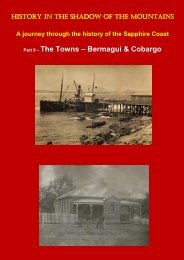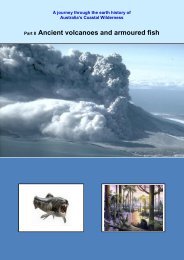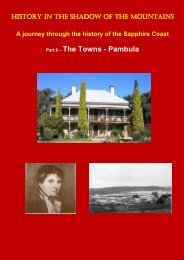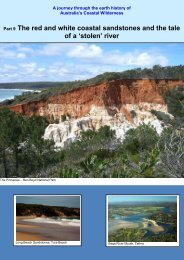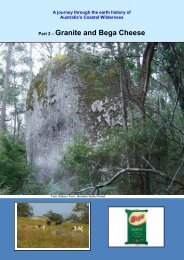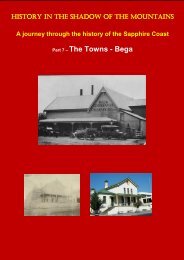DOT POINTS FOR MD11/1755 â Narooma Charters - Sapphire Coast
DOT POINTS FOR MD11/1755 â Narooma Charters - Sapphire Coast
DOT POINTS FOR MD11/1755 â Narooma Charters - Sapphire Coast
Create successful ePaper yourself
Turn your PDF publications into a flip-book with our unique Google optimized e-Paper software.
Spotted gum, Mimosa Rocks National ParkIn this photograph another ancient plant is common, the Burrawang, a cycad(Macrozamia communis) dating back to the time of the Gondwana supercontinent. Itis a cone-bearing plant of the same group as pines and other conifers(gymnosperms).Although the Ordovician sandstones and mudstones were originally laid down as flatlayers on the deep sea floor, the beds forming the headlands around Twofold Bayoften stand almost vertically, or have a wavy appearance caused by the squeezingand crunching that they have undergone. A walk around the coastal cliffs nearQuarantine Bay, within Twofold Bay west of Eden, reveals these features. Waveattack on the base of the cliffs undermines the rock, causing collapse of large chunksof cliff on to narrow beaches, where wave action gradually wears away the bits ofrock. One day the pieces of rock will be sand sized particles and part of a new sandybeach.The <strong>Narooma</strong> TerraneYou are now familiar with the way in which the Ordovician Bega Terrane plastereditself against the growing continent. There was another later Ordovician interloper,the <strong>Narooma</strong> Terrane, which rafted some even older Ordovician and Cambrian rockssome 2500 km across the ocean to pile up against the Bega Terrane.
The <strong>Narooma</strong> Terrane extends from areas near Batemans Bay and down to aroundMallacoota in Victoria. It is likely to occur in bedrock offshore and in the submergedZealandia (the large chunk of the Gondwanan continent between Australia and NewZealand). The terrane is interpreted as being ocean floor. It includes cherts derivedfrom deep ocean ooze, submarine (oceanic) basalt and a range of youngerOrdovician sediments that accumulated as the terrane slowly approached thecontinent before collision.A distinctive feature of this terrane is Camel Rock on the northern part of HaywardsBeach north of Bermagui.Camel RockCamel Rock from Haywards Beach BermaguiCamel Rock is made up of turbidite. Adjacent to it is oceanic basalt, possibly ofCambrian age around 500 Mya, making them the oldest rocks in NSW outside ofBroken Hill near the South Australian border. Compared with the age of the rocks atBroken Hill (1710-1640 Mya) Camel Rock is a youngster.
Oceanic Basalt next to Camel Rock, BermaguiAs an aside, Western Australia’s venerable Jack Hills rocks in the Pilbara which, at4,400 million years, include the oldest identified minerals on earth.Another site well worth the visit is the beach near the golf club in <strong>Narooma</strong>. Theheadland rocks at each end of the beach illustrate well the unusual rock formationsfound in the <strong>Narooma</strong> Terrane, including mélange.Mélange is a geological mess. It is usually formed in the debris scraped off adescending oceanic plate above a subduction zone.MélangeDeformed turbidites
This site also shows pillow lava. This is lava extruded onto the ocean floor. Thecooling action of sea water (often under immense water pressure) result in the lavaexuding like tooth paste and cooling into pillow structures. These are seen at<strong>Narooma</strong> Beach.Pillow Lava – <strong>Narooma</strong> Surf Club Beach




